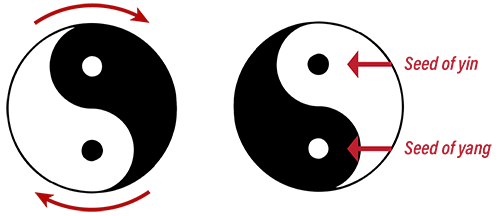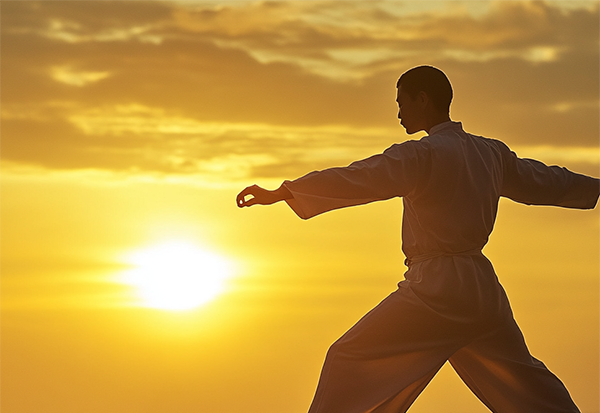
In recent years it has become popular for people to talk about their sympathetic and parasympathetic nervous systems, with a lot of emphasis put on the importance of allowing the parasympathetic nervous system to become active so that it can perform its functions properly. Unfortunately, as is common with many ‘fads’ the rhetoric around this sometimes goes a bit far, and those who take it on face value could be excused for thinking that the sympathetic nervous system is somehow ‘bad’ or ‘evil’. Of course this is ridiculous – every part of our body has it’s equally important roles to fulfil – including the sympathetic nervous system. So in this article we will present a balanced view of the sympathetic and parasympathetic nervous system, their relationship to fundamental aspects of Chinese philosophy, and the importance of giving our sympathetic nervous system some love as well (not just the parasympathetic nervous system).
What are the Sympathetic and Parasympathetic Nervous System?
The sympathetic and parasympathetic nervous systems are the two main divisions of the autonomic nervous system which controls many of the functions of our internal organs. Things like heart rate, liver function, body temperature, sweating, and even sexual responses. The nerves of the sympathetic nervous system originate primarily from the thoracic and lumbar portions of the spine, while the nerves of the parasympathetic nervous system originate from the base of the skull and the sacral portion of the spine, branching through the body and with major plexuses located towards the front of the body (this will be insightful as we connect this with aspects of Chinese philosophy later).

In very basic terms you can think of the sympathetic nervous system as the accelerator for many of our body’s organ’s functions – making them go faster and stronger when needed to support strenuous activity, like having to run, or lift heavy weights, throw something, or even fight. The parasympathetic nervous system is the complementary pair to the sympathetic nervous system, perhaps like a brake or a throttle, it slows down and relaxes the functions of many of the internal organs – which in turn allows them to perform other functions more effectively which are best done at rest, for example digestive and sexual functions.
In a world where many people have put too much emphasis in their lives on going harder and faster for too long, overactivating their sympathetic nervous system, it is easy to see how they could then think that to bring balance all they need is to shift their focus onto activating their parasympathetic nervous system instead – so that they can cause their body to move into a more restful state. In the common modern terminology this is known as moving from sympathetic dominance to parasympathetic dominance. Unfortunately, it is not quite that simple…
It is certainly relevant and useful for someone with habits of pushing themselves too hard to learn how to slow down and rest more effectively, but there is a bit more to it than just switching from one state to the other… as with so many things, what is really needed is to find balance and harmony between activating each of these branches of the nervous system.
How do the Sympathetic and Parasympathetic Nervous System Relate to Chinese Philosophy?
This idea of the necessity of balance and harmony is deeply embedded within Chinese philosophy, and understanding how the sympathetic and parasympathetic nervous systems relate to some fundamental aspects of Chinese philosophy might help us to work with our nervous systems in a way that more effectively helps us to achieve what we really want – health, vitality, and abundant energy.
If we look at the overall qualities of the functions of the sympathetic nervous system – activating, making things go faster or harder, we would describe these as being characteristically yang, the qualities of the functions of the parasympathetic nervous system – relaxing, slowing down etc, fit nicely with the characteristics of yin. Yin and yang are polar opposites which occur in all aspects of life. Chinese philosophy recognises the need for this polarity in order to create movement and life. Taiji is the principle of working harmoniously with yin and yang so that they create smooth flowing healthy energy.
Below is the famous Taijitu, or great polarity diagram, that illustrates some important aspects of the harmonious relationship between yin and yang.

One important principle that is illustrated within this diagram is that when their is a harmonious relationship – yin flows into yang, supporting it, and yang flows into yin supporting it as well. There is a mutually beneficial relationship between each of these polar opposites. Another important principle is that yin always contains the seed of yang and yang always contains the seed of yin. This means that in order for the next phase of polarity to manifest in a healthy way, the previous phase of polarity needs to be expressed first.
A simple example of these principles is that of overall activity and sleep. If you work hard all day, or do some vigorous exercise, then when we have a healthy relationship between yin and yang, this leads to rest or sleep coming naturally and easily. Similarly, when we have slept well and our yin and yang are in harmony, it is natural for us to feel energetic and ready to be active again! Both are equally important to the health of each other, and the vitality of the whole.
The problem with switching our focus to just one of these phases of polarity (in the recent faddish interpretation of the functioning of our nervous system, this would be focusing only on the parasympathetic nervous system), is that one can’t be healthy without the other. If all you do is focus on sleeping all day… then you are unlikely to sleep well at night. We need the phase of activity (sympathetic activation) to support the phase of rest (parasympathetic activation). The converse is of course also true, if you work to excess it is common to enter a state of exhaustion where you are unable to rest or sleep effectively, which then prevents us from continuing effectively with more activity the next day – yin is also needed to support yang.
Another very tangible example of this can be seen in what keeps our muscles strong and healthy. To make our muscles strong we need to exercise them (yang), but if we just activate them and keep them contracted continuously, then rather than getting stronger they start to atrophy. Clearly the muscles need relaxation as well to be healthy. If instead of focusing only on contracting our muscles we instead focus only on relaxing them… well again they will quickly start to atrophy. So alternation between activity and rest, yin and yang, is essential to the health and strength of our muscles.
What Happens When Our Sympathetic Nervous System Has Been Overworked?
In some ways we can think of the flow of energy that comes from this process of alternating between yin and yang, activity and rest, as being like a wheel turning. When there is harmony and balance between yin and yang the wheel is smooth and round and rolls easily. When one side of these polar relationships have been focused on excessively, a range of different situations can occur. Sometimes, at a mild level, it is just that the wheel has become stuck in one phase – its not really damaged, so simply giving it a good push, and starting to alternate between yin and yang, parasympathetic and sympathetic activation, will be enough to get it rolling again. On the other hand, if the imbalance is more extreme, perhaps their has been excessive sympathetic stimulation for a long time, or their has been strong spikes in activation, the wheel may be damaged. This could range from a flat tire, to some major dents or bulges in the wheel, meaning that it can’t turn easily by simply focusing on the other phase of polarity (parasympathetic activation). The damaged phase needs to be nurtured back into health as well.
This means that yes – certainly we need to focus on making sure that we activate the parasympathetic nervous system in a healthy way, and give plenty of opportunity for rest and all of the important bodily functions that go with it, but we also need to relearn how to activate our sympathetic nervous system in a healthy way, and even physically strengthen and heal the sympathetic nerves. We can’t avoid the alternation between activity and rest, it is essential to the flow of energy and life itself, so if we only focus on working with and improving the parasympathetic (rest and relaxation), whenever we need to switch back into sympathetic activation, the issue will still be there and our energy won’t flow. This will also mean that our work with the parasympathetic nervous system will be less effective, because it will not be supported by healthy yang sympathetic activity.
It could be that our sympathetic nervous system has been worked so hard that it has collapsed, and is now very difficult to activate at all – leading to a constant sense of exhaustion, no matter how much rest we get, and difficulty feeling energetic or excited about anything… It could also be that whenever the sympathetic nervous system needs to be activated, there is still a pattern of a tendency towards excess stimulation there, quickly leading to overactivity. Or it could be that when the sympathetic nervous system is activated, it does so in an irregular way – some parts becoming more active than others, the energy getting blocked in some parts of the body, leading a rough uneven activation – a bit like an out of tune engine sputtering and vibrating when you step on the accelerator.
In any of these situations, the solution is not ‘just’ to rest the sympathetic nervous system and focus on the parasympathetic. To become truly healthy, well, and balanced, the sympathetic nervous system needs to be nurtured back into health as well, and this often requires conscious focused effort. Learning to activate the system gently rather than all at once. Learning when you have had enough activation and it is time to flow into the next phase of rest to support your overall energy flow. Learning to activate the sympathetic nervous system smoothly, bringing activation in a healthy way evenly to every part of your body.
This can be quite a process, and it is likely along the way that you will from time to time overdo things and activate your nervous system too much, or that sometimes the activation might be a bit rough and uneven – all of this is part of the process of learning to become skillful with your body and energy for your ultimate health and wellbeing.
Qigong Offers Tools for Nurturing Your Sympathetic Nervous System
Qigong means energy work or skill (qi translates as energy, and gong translates as work or skill), and as the alternating flow between the polarities of yin and yang are so fundamental to the flow and health of our energy, of course qigong offers many tools that help us to bring balance to this polarity, and strengthen one or the other when we need to.

One very simple practice that is a good place to start in balancing your yin and yang polarities and maintaining a harmonious flow between them is called the micro cosmic orbit. This practice circulates energy up your spine and down the centre of the front of your body through two important meridians (pathways of energy flow) within the body. The governing vessel runs from the pelvis up through the spine and over the top of the head, and carries the main yang flows of energy in the body. The conception vessel runs from the pelvis up the centre of the front of the body to just below the mouth, and carries the main yin flows of energy in the body. Interesting how the yin and yang qualities of the energy flow within these meridians corresponds to the locations in the body where the nerves of the sympathetic nervous system originate, or where the nerves of the parasympathetic nervous system gather in plexuses? This circulation of energy directly effects these nerves with an alternating physical stimulation to bring healthy activity to each of them in a way that they harmoniously flow from one to the other. You can learn how to do this practice using simple movement, and the principles of how it works in the free Introduction to Qigong Theory and Practice course.
In the Elemental Alchemy Qigong program we explore a variety of different practices that work with the fundamental states of our energy. One of these sets of practices focuses specifically on Taiji, or the harmonious alternation between yin and yang and the vitality this give to our energy. You can find the details of that program here.
The Inner Fire Qigong program focuses on more yang or active types of qigong practice. These include dynamic Inner Fire Breathwork, Wild Animal Play, and Iron Shirt Qigong. Each of these practices requires healthy activation of our sympathetic nervous system to develop the yang quality of the energy within them. Because these practices can be quite strong, we also focus on some very yin practices within the program to maintain balance and support the overall development of our energy. You can find the details of that program here.
Of course the principle of yin and yang is so fundamental to the health of our energy, that all qigong practices have this principle embodied within them to a greater or lesser degree. The practices mentioned above are just a few which put a specific direct focus on these principles, and may be particularly beneficial to someone needing to rehabilitate and nurture their sympathetic nervous system, to find balance within their system and energy as a whole.
I hope you have found the principles we have discussed in this article interesting and useful to you. We hope that you will come back and read more of our articles in the future, and maybe even give some of the qigong practices a try. To stay up to date with our latest articles and course announcements you can subscribe to our email newsletter below.